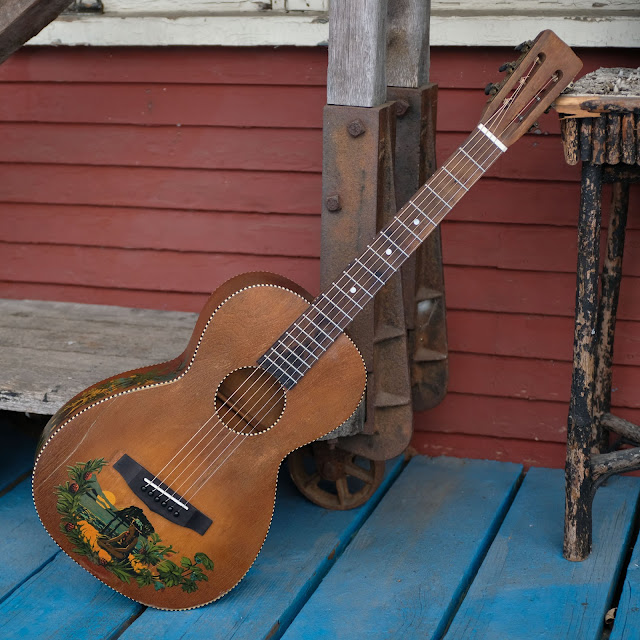1930s Harmony-made Hawaiian-decal Parlor Guitar
Parlors like this one (with its prominent Hawaiian decals) were made to be strung-up with raised-strings in Hawaiian fashion from their inception. That's what the market desired like hotcakes in the '20s and early '30s. They were fitted with extender nuts at the factory and most seem to have been played that way for a decade and then given-up to closets to become worm-food. I've seen this model several times and it's often found branded with a Supertone (Sears) label in the soundhole.
This poor, ravaged old guitar was sent in by a customer for repair. It'd had a bunch of old "work" done to it -- crack "repairs" and refinish to the back, crack "repairs" to the top, an epoxy-tastic neck reset (at least the angle was good), funky tailpiece/floating bridge setup change, and attempts to solve the nasty issue of the ebonized fretboard's passive destruction.
The owner wanted to turn it into a playing box for a friend of his, and so my own work was the necessary stuff to do that -- a board level and refret (with medium/jumbo stock), new glued-down pin-bridge (as originally intended) and bone saddle, a new bone nut, cleats for the biggest back crack, general cleaning, and a good setup. It's now an excellent player with 3/32" E and 1/16" ADGBE action at the 12th fret, a straight neck, and a slick feel due to the new frets. It's strung with 46w-10 steel as these tend to self-destruct with heavier gauges.
I love the look of the celluloid, checker binding that's on both the top and back edges. I'm also sure the medium-brown sunburst stain was an attempt to evoke the mahogany and koa of fancier Hawaiian guitars.
The body is 12 3/4" on the lower bout and has 3 5/8" depth at the endblock.
The 1 7/8" nut is a little wider than the guitars Harmony was making that were intended for "Spanish" play at the time -- those were mostly 1 3/4" in width. The board profile is flat and the neck has a medium-soft-V shape to it.
I like the way the grain now pops a bit more out of the stained-maple fretboard. The dots are pearl and I added side dots, too.
There's plenty of saddle for adjustments. The pins are boring, black plastic ones from my spare-parts-bins.
You can't argue with that cool decal!
Despite the rigidly-epoxied "neck reset" job, I also installed a hidden screw/bolt at the inside of the neck block just for safety's sake. Judging by the other repairs (including a 1"-thick piece of plywood glued to support a crack on the top), who knows what might happen to this in the future left alone?
I added the old-fashioned aluminum strap buttons.
The tuners on this side are pretty normal.
How do you like that old-school splice-in, though?!




















Comments